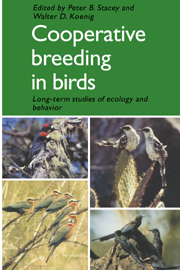Book contents
- Frontmatter
- Contents
- Contributors
- Introduction
- 1 Splendid Fairy-wrens: demonstrating the importance of longevity
- 2 Green Woodhoopoes: life history traits and sociality
- 3 Red-cockaded Woodpeckers: a ‘primitive’ cooperative breeder
- 4 Arabian Babblers: the quest for social status in a cooperative breeder
- 5 Hoatzins: cooperative breeding in a folivorous neotropical bird
- 6 Campylorhynchus wrens: the ecology of delayed dispersal and cooperation in the Venezuelan savanna
- 7 Pinyon Jays: making the best of a bad situation by helping
- 8 Florida Scrub Jays: a synopsis after 18 years of study
- 9 Mexican Jays: uncooperative breeding
- 10 Galápagos mockingbirds: territorial cooperative breeding in a climatically variable environment
- 11 Groove-billed Anis: joint-nesting in a tropical cuckoo
- 12 Galápagos and Harris' Hawks: divergent causes of sociality in two raptors
- 13 Pukeko: different approaches and some different answers
- 14 Acorn Woodpeckers: group-living and food storage under contrasting ecological conditions
- 15 Dunnocks: cooperation and conflict among males and females in a variable mating system
- 16 White-fronted Bee-eaters: helping in a colonially nesting species
- 17 Pied Kingfishers: ecological causes and reproductive consequences of cooperative breeding
- 18 Noisy Miners: variations on the theme of communality
- Summary
- Index
8 - Florida Scrub Jays: a synopsis after 18 years of study
Published online by Cambridge University Press: 07 September 2010
- Frontmatter
- Contents
- Contributors
- Introduction
- 1 Splendid Fairy-wrens: demonstrating the importance of longevity
- 2 Green Woodhoopoes: life history traits and sociality
- 3 Red-cockaded Woodpeckers: a ‘primitive’ cooperative breeder
- 4 Arabian Babblers: the quest for social status in a cooperative breeder
- 5 Hoatzins: cooperative breeding in a folivorous neotropical bird
- 6 Campylorhynchus wrens: the ecology of delayed dispersal and cooperation in the Venezuelan savanna
- 7 Pinyon Jays: making the best of a bad situation by helping
- 8 Florida Scrub Jays: a synopsis after 18 years of study
- 9 Mexican Jays: uncooperative breeding
- 10 Galápagos mockingbirds: territorial cooperative breeding in a climatically variable environment
- 11 Groove-billed Anis: joint-nesting in a tropical cuckoo
- 12 Galápagos and Harris' Hawks: divergent causes of sociality in two raptors
- 13 Pukeko: different approaches and some different answers
- 14 Acorn Woodpeckers: group-living and food storage under contrasting ecological conditions
- 15 Dunnocks: cooperation and conflict among males and females in a variable mating system
- 16 White-fronted Bee-eaters: helping in a colonially nesting species
- 17 Pied Kingfishers: ecological causes and reproductive consequences of cooperative breeding
- 18 Noisy Miners: variations on the theme of communality
- Summary
- Index
Summary
The Florida Scrub Jay (Aphelocoma coerulescens coerulescens) is a disjunct population of a species that otherwise inhabits western North America from Oregon and Colorado south to southern Mexico. Two other, largely Mexican species complete the genus Aphelocoma. The genus is unusually revealing for studying the evolution of cooperative breeding, because it contains closely related populations that exhibit varying degrees of sociality both between species and within species. The hypothesis that these differences are associated with different environmental and demographic conditions is central to most current work on social evolution in jays (Brown 1974, 1978; Woolfenden and Fitzpatrick 1984; Fitzpatrick and Woolfenden 1986).
The Scrub Jay is known to exhibit cooperative breeding only in the Florida population, where it occurs in scattered, often small populations, restricted to relict patches of oak scrub. This population has almost certainly been isolated from the vast western populations since at least the Pleistocene (Pitelka 1951). In contrast to the Florida population, Scrub Jays in the west disperse from the natal territory before reaching the age of one year. Here, we describe the social system of the Florida Scrub Jay, placing it in its environmental context as a means of emphasizing our interpretation of how the system evolved.
Study area and methods
Several hundred Florida Scrub Jays reside permanently on the property of the Archbold Biological Station, located in Highlands County near the southern terminus of the central Florida hill country (known as the Lake Wales Ridge).
- Type
- Chapter
- Information
- Cooperative Breeding in BirdsLong Term Studies of Ecology and Behaviour, pp. 239 - 266Publisher: Cambridge University PressPrint publication year: 1990
- 40
- Cited by

